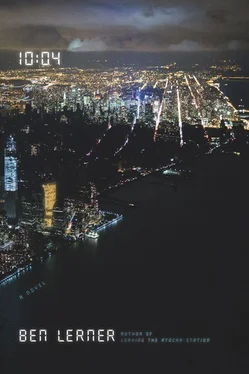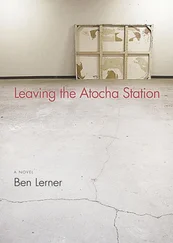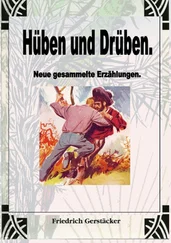We stopped before a display explaining the development of the vertebrate jaw and, as I instructed Roberto to sketch the remains of a pterosaur in his notebook, I felt despair spread through me like contrast dye. The eight-year-old is having a fine time learning about evolution while his guide is freaking out because of all the strangers and stimulation; I was the nervous kid far from home longing for my parents, not Roberto; I was the one who kept clinging to his hand; I’d become the unreliable narrator of my first novel. Roberto tried to bolt with excitement toward the next alcove and I instinctually grabbed his arm to stop him, jerking it a little. “Ow,” he said, not hurt, but understandably disconcerted. I said I was sorry and knelt down and looked him in the eye and explained to him in Spanish, no doubt visibly pale and perspiring, that we must avoid getting separated. Then I told him, probably sounding as if I were giving orders for a suicide mission, that if we somehow did lose each other, we should meet at the Tyrannosaurus rex skeleton. He smiled, but didn’t say anything; I wondered if he was embarrassed for me.
We entered the Hall of Saurischian Dinosaurs — a room containing some of the museum’s most impressive fossil displays — and found the apatosaurus skeleton, recently remounted to reflect new research, a placard explained, about how the dinosaur was likely to have carried itself; the tail was now aloft, no longer dragging on the ground. There was a large group of Asian children, Korean I guessed, standing around the skeleton in matching blue T-shirts, listening to their guide; Roberto couldn’t get as close as he wanted to the bones. By the time I finished asking him to sketch the tail, he had rushed off with excitement toward the allosaurus depicted feeding on a carcass. I followed him with enforced calm, stood beside him and uttered some vaguely educational instruction, and then he ran to the next arrangement of mineralized tissues and I followed. This was how we proceeded through the hall, Roberto occasionally reversing the evolutionary course by sprinting back to see a highlight — I at least had the presence of mind to take his picture on my cell phone before the giant Tyrannosaurus rex , mounted as if stalking prey — and then running back to the future to admire, say, some protoceratops skulls arranged in a growth series. As long as I keep him within sight, I told myself, everything will be fine; it’s not as though there are kidnappers lurking among the relatives of extinct mammals; most crazy people can’t afford the exorbitant admission price.
Around the time the synapsid opening evolved, I realized I had to pee. I asked Roberto if he had to go to the bathroom and he said no and darted off again. I would have to hold it; there was no way I was going to leave him unsupervised while I went, and I couldn’t imagine dragging him into the men’s room so I could piss. All over the world people were tending their children ingeniously in the midst of surpassing extremities, seeing them through tsunamis and civil wars, shielding them from American drones, but I was at a total loss as to how one could both be responsible for a child at a museum and empty one’s bladder. I followed Roberto through the Hall of Mammals and their extinct relatives, taking another picture of the boy before the brontops, who most likely subsisted on a diet of soft leaves. I caught myself shifting my weight a little from foot to foot as the cell phone made its simulated click, something I did as a child when I had to go to the bathroom, and I had an involuntary memory of wetting myself at the Topeka Zoo at four, having refused to go when I had the chance, the humiliating warmth spreading down my leg, darkening my corduroys.
By the time we stood together before the great mammoth skeleton at the end of the vertebrate cladogram — the mummified remains of a baby woolly mammoth displayed in a case beside the pedestal — I had regressed so severely that it felt like a form of devolution. Roberto calmly if clumsily sketched the great curving tusks while I tried not to wet myself and longed for a guardian. Half the men walking around the fossils seemed to have a baby strapped to their chests and I tried to reassure myself by remembering that Alex, the sanest person I knew, believed I was genetically and practically competent to be a father, to perpetuate the species. But why, exactly, had she selected me? Because we were best friends, of course — because our relationship was more durable than any marriage we could imagine, because she thought I was smart and good. I had never really doubted myself enough to doubt her reasons, but now it occurred to me with the force of revelation: She wants you to donate the sperm precisely because she doesn’t think you’d ever get it together enough to be an active father; she’s much more afraid of raising a child with an onerous father than without a father at all; she comes from a line of self-sufficient women whose partners disappear. You appeal because you’ll be sweet and avuncular and financially supportive and someone she can talk to for emotional advice, but she assumes you’re too scattered and scared to intervene dramatically in the child’s early development and daily life. She doesn’t want to do it entirely alone, but she doesn’t want to do it with a full partner; you come from great stock — Alex loved my parents — and will never go totally AWOL, but you’re also sufficiently infantile and self-involved to cede all the substantial parenting to her. She chose you for your deficiencies, not in spite of them, a new kind of mating strategy for millennial women whose priority is keeping the more disastrous fathers away, not establishing a nuclear family.
“I have to go to the bathroom, Roberto. Why don’t you come with me?”
“I don’t have to go.”
“Come with me and wait for me.” I was shifting my weight back and forth again.
“I’ll wait for you here.”
“You are coming with me. Now.”
“But—”
“Do you want something from the gift shop or not?”
As we approached the restrooms I repeated to Roberto that if he was in the exact spot I left him in when I came back out he could have a gift of his choice. I tried to joke away my worry and enlist his compliance by making it a game: see if you can stand as still as a fossil. I parked him beside the drinking fountain and went into the restroom while he positioned himself in a dinosaur pose, and when I emerged tremendously relieved two and a half minutes later I found that he was gone. Terror seized me and I had to keep myself from running back toward the galleries. As soon as I turned the corner, he leapt out at me, shrieking like a velociraptor. Before it dissipated, the fear turned to fury, and I knelt down and gripped his shoulders and all my accumulated anxiety and self-loathing issued forth in a hiss: I am going to tell your mom you’ve misbehaved; you’re not getting anything from the gift shop.
Roberto, eyes lowered, said he was just joking and hadn’t gone far and hadn’t done anything wrong. As my fury dissolved into remorse, he turned and walked away from me. For a second I feared he’d accelerate and try to lose me — he didn’t respond when I called his name — but instead he walked slowly and dejectedly to the stairs and descended to the third floor and I followed a few feet behind as he moped through the dioramas of Pacific Peoples and Plains Indians. The surrounding nineteenth-century taxidermy and painted backgrounds felt at once dated and futuristic: dated because low-tech and methodologically presumptuous and insensitive; futuristic because postapocalyptic: it was as if an alien race had tried to reconstruct the past of the wasteland upon which they’d stumbled. It reminded me of Planet of the Apes or other movies from the sixties and seventies that I’d seen as a child in the eighties — movies whose distance from the present was most acutely felt in the quaintness of the futures they projected; nothing in the world, I thought to myself, is as old as what was futuristic in the past.
Читать дальше










